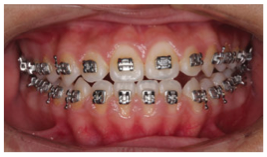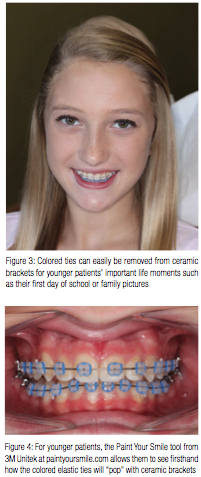Dr. Paul Tran explores the advantages of ceramic brackets
As orthodontists, we often think of esthetics as a final result — a patient comes in with malaligned teeth, and we give them a beautiful smile at the end of treatment. However, I will be the first to admit that as orthodontists, we don’t always pay close enough attention to the treatment process in its entirety. In order to achieve a successful esthetic result, we must focus on esthetics during the complete treatment journey, from the tools and materials we utilize to the brackets themselves.
 While my practice still offers metal brackets, we have successfully adopted esthetic brackets and are quickly moving toward becoming a practice that exclusively offers esthetic options to our patients. We have developed a unique concept for approaching the choice between metal and ceramic, and from a practice growth standpoint, it has proven to be one of the best moves we’ve ever made. I’d like to share with you how we accomplished this and provide tips on how to effectively make this transition with both your adult and teen patients.
While my practice still offers metal brackets, we have successfully adopted esthetic brackets and are quickly moving toward becoming a practice that exclusively offers esthetic options to our patients. We have developed a unique concept for approaching the choice between metal and ceramic, and from a practice growth standpoint, it has proven to be one of the best moves we’ve ever made. I’d like to share with you how we accomplished this and provide tips on how to effectively make this transition with both your adult and teen patients.
In the beginning
When I began practicing in the ortho-dontic field 20 years ago, I primarily used metal brackets and treated only a select few adult patients with ceramic brackets. At the time, ceramic brackets were not as efficient — they were harder to debond, bulky, and shattered frequently. Like many of my colleagues, I tried to talk my patients out of ceramic brackets because I didn’t feel that they offered an effective solution.
 When clear aligners came into the market about 15 years ago, they were heavily promoted throughout the orthodontic world. We saw the market respond to the promotions, and patients began to ask for clear aligners. While we initially treated patients with clear aligners to meet this growing demand, we recognized that traditional braces were more effective, easier to maintain, and achieved the best final result.
When clear aligners came into the market about 15 years ago, they were heavily promoted throughout the orthodontic world. We saw the market respond to the promotions, and patients began to ask for clear aligners. While we initially treated patients with clear aligners to meet this growing demand, we recognized that traditional braces were more effective, easier to maintain, and achieved the best final result.
As demand grew for clear aligners, it became obvious that there was a fervent need for esthetic solutions. When we were introduced to ceramic systems such as Clarity™ Metal-Reinforced Ceramic Brackets from 3M Unitek, it was clear that this was a completely advanced product. The quality, ease of debonding, strength, and durability of these ceramic brackets were so impressive that we decided to use 3M Clarity brackets with the majority of our patients. Ceramic brackets became our solution to meet the growing demand for esthetic products and gave our patients the superior smiles we both desired.
 To be clear — clinically, ceramic brackets are no different than traditional metal brackets. There is no learning curve when making the transition, and in my experience, debonding is considerably easier. I now work with Clarity™ ADVANCED Ceramic Brackets from 3M Unitek and have had excellent results. If you can use a metal bracket on a patient, you can also use a ceramic bracket.
To be clear — clinically, ceramic brackets are no different than traditional metal brackets. There is no learning curve when making the transition, and in my experience, debonding is considerably easier. I now work with Clarity™ ADVANCED Ceramic Brackets from 3M Unitek and have had excellent results. If you can use a metal bracket on a patient, you can also use a ceramic bracket.
A unique perspective on pricing
When we began the transition toward an almost exclusive ceramic practice, we made a major decision that has set us apart from other practices: We decided that whether a patient wanted metal or ceramic, we would charge the same fee. How is this possible? Even though ceramic brackets have a higher initial cost compared to metal brackets, our office overhead never changed significantly. However, the benefits we saw were an increase in new patients seeking esthetic solutions, and that itself more than made up for the cost difference, especially when spread over a number of patients every month.
 For our patients, removing cost concerns from the equation eliminated the difficult part of their decision process, and now they overwhelmingly choose ceramic brackets for their treatment. For our practice, we receive a greater benefit from being perceived as a top-notch esthetic practice with happy patients than we would from pinching a few pennies. In the last 5 years, our practice has not purchased a single traditional metal bracket on a patient’s upper arch (not including molar brackets).
For our patients, removing cost concerns from the equation eliminated the difficult part of their decision process, and now they overwhelmingly choose ceramic brackets for their treatment. For our practice, we receive a greater benefit from being perceived as a top-notch esthetic practice with happy patients than we would from pinching a few pennies. In the last 5 years, our practice has not purchased a single traditional metal bracket on a patient’s upper arch (not including molar brackets).
Since transitioning to ceramic brackets and offering a level playing field in terms of associated costs to our patients, we have seen incredible growth in our practice. We believe that this is attributable directly to the superior esthetics we’re offering, and the fact that our patients aren’t afraid to talk about it. Referrals and word of mouth are indispensable in creating a solid reputation and a steady patient stream.
Esthetic solutions for the younger crowd
When the fee scale is equal, adults don’t generally need any additional encouragement to opt for ceramic brackets. Younger patients, however, have different priorities, and sometimes require us to take extra time to explain why we recommend clear brackets, since most of their friends are still wearing traditional metal braces and they want to “fit in.” I begin conversations with my younger patients and their parents by discussing major life moments. Transitioning into high school is a big step for the majority of them (Figure 3). We want them to be able to laugh and smile without being self-conscious about their braces on the first day of school. We discuss color options, and they’re usually amazed when they see how much the colored elastic ties “pop” on a ceramic bracket (Figure 4). We always tell their parents that the beauty of ceramic brackets is that the colored bands can always be replaced with clear for important milestones or pictures.
A great resource we have used for younger patients is the Paint Your Smile tool from 3M Unitek at paintyoursmile.com. This website allows us to upload a “selfie” of the patient and show them what their ceramic braces will look like compared to traditional metal braces. The website lets them test-drive different colored bands on their braces before committing to a treatment option. Giving younger patients this type of platform to create their own smile gives them some independence when coming in with their parents.
 The take-aways
The take-aways
If you see the advantage in transitioning to ceramic brackets in your practice, it’s important to be prepared to position this esthetic solution as a value-add to your patients and clearly communicate the benefits. While it’s not always as easy as a patient walking in and asking, “Can I have ceramic brackets?”— when the patients understand what they will gain from a truly esthetic treatment plan, their experience is instantly elevated (Figure 5). For me, there are three things that have been most important in making this a successful transition:
- Thinking creatively — By implementing an equal pay scale for traditional metal and ceramic brackets, we help our patients enjoy outstanding results and, at the same time, grow the practice and establish a positive reputation in our community.
- Training staff — In order to get buy-in from your patients, your staff has to be educated about the benefits and fully committed to furthering the goal.
- Utilizing resources — You are not alone in wanting to make a positive change in your practice. I rely heavily on my 3M Unitek sales representatives to field my questions, help brainstorm new ideas for marketing, and collaborate on how to best communicate product benefits.
As orthodontists, it’s our duty to offer the best possible solutions for our patients, and in my opinion, ceramic brackets help me to accomplish this every day (Figure 6).
Stay Relevant With Orthodontic Practice US
Join our email list for CE courses and webinars, articles and mores


